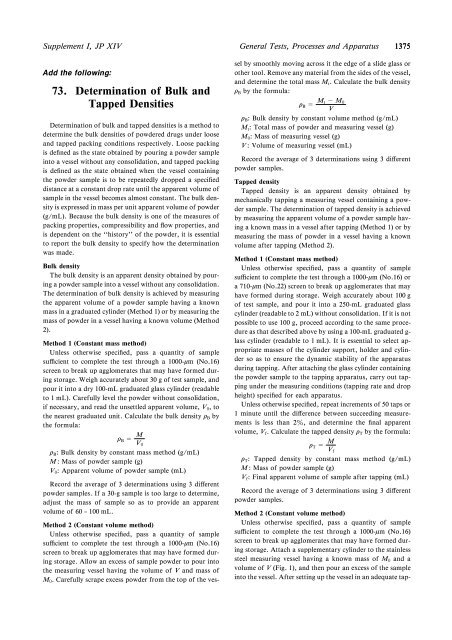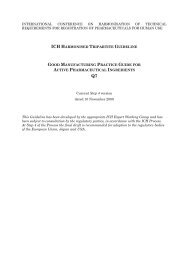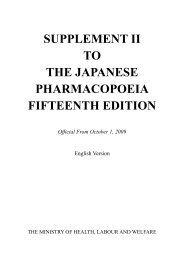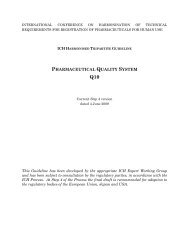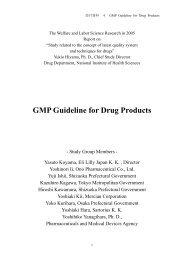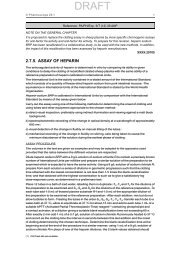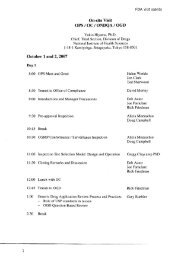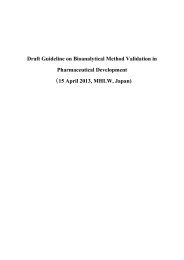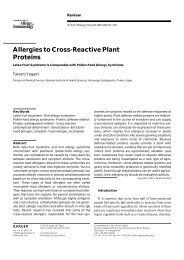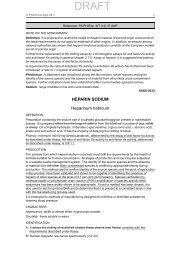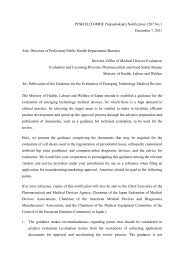Supplement I to the Japanese Pharmacopoeia Fourteenth Edition
Supplement I to the Japanese Pharmacopoeia Fourteenth Edition
Supplement I to the Japanese Pharmacopoeia Fourteenth Edition
You also want an ePaper? Increase the reach of your titles
YUMPU automatically turns print PDFs into web optimized ePapers that Google loves.
<strong>Supplement</strong> I, JP XIV<br />
General Tests, Processes and Apparatus<br />
1375<br />
Add <strong>the</strong> following:<br />
73. Determination of Bulk and<br />
Tapped Densities<br />
Determination of bulk and tapped densities is a method <strong>to</strong><br />
determine <strong>the</strong> bulk densities of powdered drugs under loose<br />
and tapped packing conditions respectively. Loose packing<br />
is deˆned as <strong>the</strong> state obtained by pouring a powder sample<br />
in<strong>to</strong> a vessel without any consolidation, and tapped packing<br />
is deˆned as <strong>the</strong> state obtained when <strong>the</strong> vessel containing<br />
<strong>the</strong> powder sample is <strong>to</strong> be repeatedly dropped a speciˆed<br />
distance at a constant drop rate until <strong>the</strong> apparent volume of<br />
sample in <strong>the</strong> vessel becomes almost constant. The bulk density<br />
is expressed in mass per unit apparent volume of powder<br />
(g/mL). Because <strong>the</strong> bulk density is one of <strong>the</strong> measures of<br />
packing properties, compressibility and ‰ow properties, and<br />
is dependent on <strong>the</strong> ``his<strong>to</strong>ry'' of <strong>the</strong> powder, it is essential<br />
<strong>to</strong> report <strong>the</strong> bulk density <strong>to</strong> specify how <strong>the</strong> determination<br />
was made.<br />
Bulk density<br />
The bulk density is an apparent density obtained by pouring<br />
a powder sample in<strong>to</strong> a vessel without any consolidation.<br />
The determination of bulk density is achieved by measuring<br />
<strong>the</strong> apparent volume of a powder sample having a known<br />
mass in a graduated cylinder (Method 1) or by measuring <strong>the</strong><br />
massofpowderinavesselhavingaknownvolume(Method<br />
2).<br />
Method 1 (Constant mass method)<br />
Unless o<strong>the</strong>rwise speciˆed, pass a quantity of sample<br />
su‹cient <strong>to</strong> complete <strong>the</strong> test through a 1000-mm (No.16)<br />
screen <strong>to</strong> break up agglomerates that may have formed during<br />
s<strong>to</strong>rage. Weigh accurately about 30 g of test sample, and<br />
pour it in<strong>to</strong> a dry 100-mL graduated glass cylinder (readable<br />
<strong>to</strong> 1 mL). Carefully level <strong>the</strong> powder without consolidation,<br />
if necessary, and read <strong>the</strong> unsettled apparent volume, V 0 ,<strong>to</strong><br />
<strong>the</strong> nearest graduated unit. Calculate <strong>the</strong> bulk density r B by<br />
<strong>the</strong> formula:<br />
r B = M V 0<br />
r B : Bulk density by constant mass method (g/mL)<br />
M :Massofpowdersample(g)<br />
V 0 : Apparent volume of powder sample (mL)<br />
Record <strong>the</strong> average of 3 determinations using 3 diŠerent<br />
powder samples. If a 30-g sample is <strong>to</strong>o large <strong>to</strong> determine,<br />
adjust <strong>the</strong> mass of sample so as <strong>to</strong> provide an apparent<br />
volume of 60 – 100 mL.<br />
Method 2 (Constant volume method)<br />
Unless o<strong>the</strong>rwise speciˆed, pass a quantity of sample<br />
su‹cient <strong>to</strong> complete <strong>the</strong> test through a 1000-mm (No.16)<br />
screen <strong>to</strong> break up agglomerates that may have formed during<br />
s<strong>to</strong>rage. Allow an excess of sample powder <strong>to</strong> pour in<strong>to</strong><br />
<strong>the</strong> measuring vessel having <strong>the</strong> volume of V and mass of<br />
M 0 . Carefully scrape excess powder from <strong>the</strong> <strong>to</strong>p of <strong>the</strong> vessel<br />
by smoothly moving across it <strong>the</strong> edge of a slide glass or<br />
o<strong>the</strong>r <strong>to</strong>ol. Remove any material from <strong>the</strong> sides of <strong>the</strong> vessel,<br />
and determine <strong>the</strong> <strong>to</strong>tal mass M t . Calculate <strong>the</strong> bulk density<br />
r B by <strong>the</strong> formula:<br />
r B = M t - M 0<br />
V<br />
r B : Bulk density by constant volume method (g/mL)<br />
M t : Total mass of powder and measuring vessel (g)<br />
M 0 : Mass of measuring vessel (g)<br />
V : Volume of measuring vessel (mL)<br />
Record <strong>the</strong> average of 3 determinations using 3 diŠerent<br />
powder samples.<br />
Tapped density<br />
Tapped density is an apparent density obtained by<br />
mechanically tapping a measuring vessel containing a powder<br />
sample. The determination of tapped density is achieved<br />
by measuring <strong>the</strong> apparent volume of a powder sample having<br />
a known mass in a vessel after tapping (Method 1) or by<br />
measuring <strong>the</strong> mass of powder in a vessel having a known<br />
volume after tapping (Method 2).<br />
Method 1 (Constant mass method)<br />
Unless o<strong>the</strong>rwise speciˆed, pass a quantity of sample<br />
su‹cient <strong>to</strong> complete <strong>the</strong> test through a 1000-mm (No.16) or<br />
a710-mm (No.22) screen <strong>to</strong> break up agglomerates that may<br />
have formed during s<strong>to</strong>rage. Weigh accurately about 100 g<br />
of test sample, and pour it in<strong>to</strong> a 250-mL graduated glass<br />
cylinder (readable <strong>to</strong> 2 mL) without consolidation. If it is not<br />
possible <strong>to</strong> use 100 g, proceed according <strong>to</strong> <strong>the</strong> same procedure<br />
as that described above by using a 100-mL graduated g-<br />
lass cylinder (readable <strong>to</strong> 1 mL). It is essential <strong>to</strong> select appropriate<br />
masses of <strong>the</strong> cylinder support, holder and cylinder<br />
so as <strong>to</strong> ensure <strong>the</strong> dynamic stability of <strong>the</strong> apparatus<br />
during tapping. After attaching <strong>the</strong> glass cylinder containing<br />
<strong>the</strong> powder sample <strong>to</strong> <strong>the</strong> tapping apparatus, carry out tapping<br />
under <strong>the</strong> measuring conditions (tapping rate and drop<br />
height) speciˆed for each apparatus.<br />
Unless o<strong>the</strong>rwise speciˆed, repeat increments of 50 taps or<br />
1 minute until <strong>the</strong> diŠerence between succeeding measurements<br />
is less than 2z, and determine <strong>the</strong> ˆnal apparent<br />
volume, V f . Calculate <strong>the</strong> tapped density r T by <strong>the</strong> formula:<br />
r T = M V f<br />
r T : Tapped density by constant mass method (g/mL)<br />
M :Massofpowdersample(g)<br />
V f : Final apparent volume of sample after tapping (mL)<br />
Record <strong>the</strong> average of 3 determinations using 3 diŠerent<br />
powder samples.<br />
Method 2 (Constant volume method)<br />
Unless o<strong>the</strong>rwise speciˆed, pass a quantity of sample<br />
su‹cient <strong>to</strong> complete <strong>the</strong> test through a 1000-mm (No.16)<br />
screen <strong>to</strong> break up agglomerates that may have formed during<br />
s<strong>to</strong>rage. Attach a supplementary cylinder <strong>to</strong> <strong>the</strong> stainless<br />
steel measuring vessel having a known mass of M 0 and a<br />
volume of V (Fig.1),and<strong>the</strong>npouranexcessof<strong>the</strong>sample<br />
in<strong>to</strong> <strong>the</strong> vessel. After setting up <strong>the</strong> vessel in an adequate tap-


